Ours in South Korea: personal competition, food cult, and plastic surgery
I always liked Asian culture.

Фото: Depositphotos
I entered in Moscow State University to the Korean language department and after the second course went to Seoul for a monthly internship.
When she graduated from undergraduate, she immediately applied to the magistracy of Seoul State University. That was four years ago. Now I live in Seoul, writing a dissertation and teaching in a private academy of Russian language.
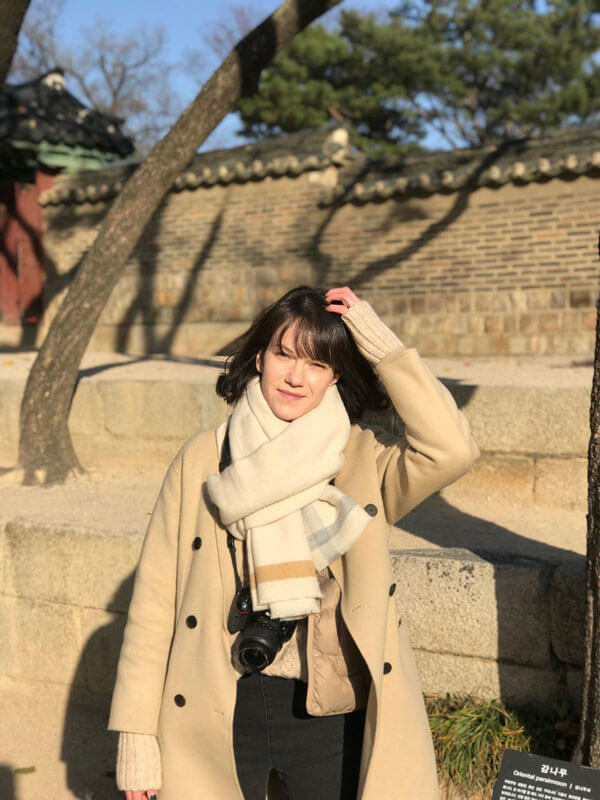
This is me in Changdeokgung Palace in Seoul - it was built in the 15 century for the royal family of the Joseon Dynasty. Photos from the personal archive
Visas
During my studies at the magistracy, I issued a D-2 study visa, which allows you to earn a few hours a day. For this you need a passport, an application, two photos, a bank statement, an invitation from the university and permission from the university for a visa - it says that the work will not interfere with the educational process. Fee for visa - 60 $. Student visa can be extended, you do not need to leave the country.
A year ago, I changed my visa to E-2: it allows you to work as a teacher in private language academies. It can be issued by those who graduated from a university in Russia and received a bachelor's degree. To change the visa, I brought a contract with an employer, an employer's license, a diploma to the immigration center. Moscow State University with apostille, certificate of medical examination, certificate of no criminal record. Fee for visa - 60 $.
The visa was issued for one year - this is the duration of my work contract. If the employer extends the contract with me, I will extend the visa.
To work full time, you need to get a residence permit - an F-2 visa. It is given on 3 of the year, after which it can be extended. Each applicant for a visa is estimated by a point system: you must dial a minimum of 80 from 120. Age, education, knowledge of the Korean language, income, experience of volunteer work are estimated. It is also usually required to go through the Korean integration program - a special course for foreigners about life in the country.
Now I just passed the exam to determine the level of the Korean language - I have the fifth, maximum. It remains to listen to the 50 hours of the integration program - and you can submit documents.
Those who do not know Korean, it is difficult to obtain a residence permit.
State services
Every foreigner who plans to stay in Korea for longer than 90 days must complete a foreigner registration card or card. For non-residents, this is the main document.

The card is called “Vagugin Tynnokchyn”. “Vagugin” in Korean means “foreigner”. For this word in the search engine you can find stories about the life of Russian immigrants in South Korea. Photos from the personal archive
To get a registration card, you need to come to the immigration center and hand over the documents: I brought an invitation from the university, an order for admission to the university, a completed application form and a photo. Three weeks later, I took the finished card.
The card contains the home address - if it changes, you should inform the immigration center about this within two weeks. Once I forgot about this rule and I was fined 70 $.
Seoul has two large immigration office offices. I came across only polite and friendly experts, never rude. Inspectors do not speak English well, so without knowledge of Korean it will be difficult. In the immigration center you can find volunteer translators - they may be able to help, but it will not be quick.
Documents here are accepted only by preliminary electronic registration. This is not always convenient: during the peak months, you cannot receive an appointment. The last time I waited my turn for a month, because a new academic semester began and there was an influx of students. With urgent issues should be taken out of turn: for example, if I have a visa expiring, I will extend it on the same day. How it works in practice, I did not check.
Salaries and work
Korean currency is called “won”. 100 ₩ is approximately 0,086 cents.
The minimum wage in Korea is 7530 ($ 6.8) per hour, 1 573 770 ($ 1 432) per month. The amount is set each year by the Ministry of Labor. Approximately get so many people working in the service sector. A friend of mine worked in the mobile service and after 2 years of work, received 1 700 000 ₩ ($ 1 556) per month.
Young, educated Koreans tend to work in large national corporations. The salary of a young specialist in such a company starts from 2,5 million ($ 2 287) per month.

A park on Yidoo Island in the center of Seoul. Here are the main banks of the country, offices of foreign and Korean corporations, as well as the National Assembly of the Republic of Korea - the so-called local parliament. Photos from the personal archive
Students begin to look for work in the fourth year. At the beginning of the first half of the year, Korean corporations publish vacancies, students choose the ones they like and send their portfolios. Further applicants will be invited to take tests - psychological and at the level of intelligence. Those who passed, will call for a series of interviews, usually three. I also have to go through all this: when I finish my master’s degree, I will look for a full-time job.
Young Koreans who have received a good education complain that it is difficult for them to find a job and are angry at the system. They have an equally good education, internship experience in local and foreign companies, but there are not so many highly paid jobs on the market. Less prestigious work is complete. The official unemployment rate in South Korea is 3,3%.
Koreans work a lot. In the standard vacancy write that the working day - from 9: 00 to 18: 00. In fact, all are delayed, the employee can not leave earlier than his immediate superior. The normal situation is when a novice works until two in the morning, in the morning he comes to 9 cheerfully: 00, and then he works on weekends.
In South Korea, a hierarchical system: if you are older in age or position, you can dispose of the younger ones. This is especially noticeable in local companies where all employees are Koreans. Usually, the leaders, people of the old school, chase the young: if they don’t like something, shit up or even give a slap in the face.
After work in men, it is customary to drink with colleagues. On the eve of the weekend, such companies will be entertained all night: in one cafe they will eat, in the other they will drink, then they go to karaoke, then they will go for coffee. Men drink a lot, drinking on weekdays is considered normal. It is even surprising that Koreans consider Russians as a more drinking nation. Korean vodka is called soju, its strength is 20%.
Raising depends on how many years you work in the company. When applying for a job, the applicant is told when he can be promoted and what needs to be done to do this: for example, pass some qualifying exam. Usually increase through 3 — 4 work years.
Holidays in Korea are small: a maximum of 10 days, so everyone is trying to relax on national holidays. On the Korean New Year, in February, 4 — 5 days rest. At the end of October - November, three dates are celebrated at once: Thanksgiving Day, Korean Writing Day and the founding day of the Korean state. Last year, these three holidays stood side by side and the whole country rested 11 days.
Taxes
PIT calculates and deducts from the salary of the employer. For employees working in Korean companies, the tax rate varies from 8 to 35% - depending on the amount of income.
Our academy keeps 3,3% from foreigners. But if the annual salary is less than 24 million won per year, you can issue a tax deduction.
Value Added Tax - 10%. It is indicated directly on the check.
Banks
In Seoul, there are about 10 large banks, their offices can be found near any metro station. There are also local banks, for example, the Busan bank, but in Seoul they are not particularly visible.
Opening an account is easy. I did not choose a bank on purpose — I went to the first branch that was located on the campus of my university. I filled out the questionnaire, then I received a card. Card design can be pre-selected on the bank website.

Recently, the popular Korean messenger KakaoTalk has created its own bank. The design of the cards used emoticons from the messenger
I use the so-called check-card - this is an advanced debit card. Unlike conventional Korean debit, it can be used at any time, not just during bank hours. Check-cards are accepted in all stores, and when paying you do not need to enter a password. Service is free.
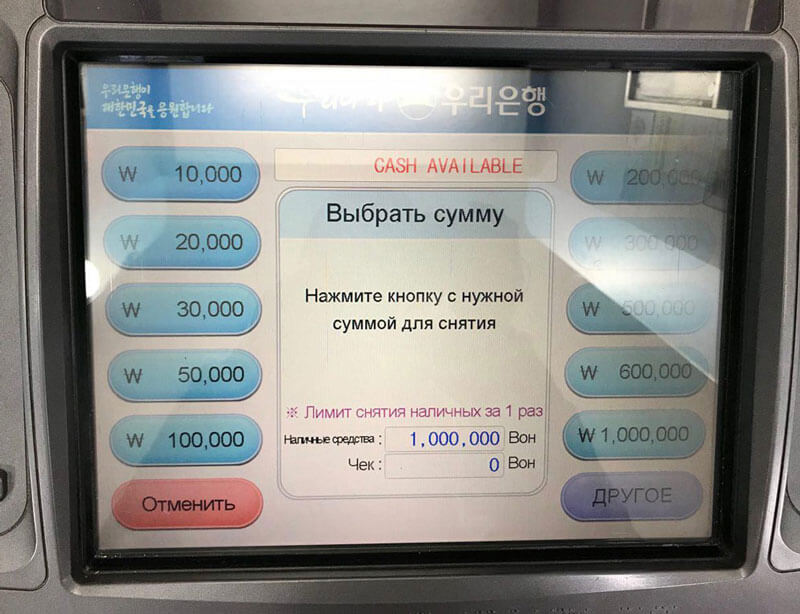
Many ATMs have Russian language. Photos from the personal archive
You can control your expenses using a mobile application. In Korea, banks are obsessed with security: to pay for a purchase on the Internet, you need to confirm your identity four times.
That's how I pay for the apartment. I open the application, access to the account - by fingerprint. I enter the account number and amount, again confirm it with a fingerprint. Then I enter the PIN card and password from a special card. It is issued in the bank along with a debit card, this is a mandatory requirement for all banks in South Korea.

To confirm the operation, you must enter the last two digits of the password No. 30 and the first two digits of the password No. 17
Buying something on the Internet in South Korea is terribly inconvenient, but you can not be afraid of scammers. I have never heard that someone stole money from a card.
It is easy to pay with a card in a store: there is a cashless settlement everywhere in large cities. Is that the market can not accept the card, if the seller is a Korean grandmother. Sometimes sellers are asked to pay in cash, but they can be refused.
Accomodation
It is easy for a foreigner to rent an apartment in Seoul, but decent housing is expensive. As a rule, apartments are rented through real estate agencies - the metro is full of their offices. For their services, the agency will take a commission.
The rental price depends on the size of the collateral: the more it is, the less you pay per month. Therefore, in Korea there are two ways to rent housing: “Volse”, with a small margin and regular monthly payments, and “Jeans”, with a huge margin, of the order of 90% of the cost of housing, but without monthly rental payments. In this case, you only pay for Housing and utilities. For apartment owners it is beneficial, because they will put a huge amount of collateral into circulation.
Room. I lived in the dormitory of my university for a year and a half, I had a double room with a shower and a toilet. Monthly rentals cost 216 000 ₩ ($ 1 99.5). Separately made a deposit - the amount of the monthly rent. He was returned when I left the dorm, only deducted a small amount for the lost keys.
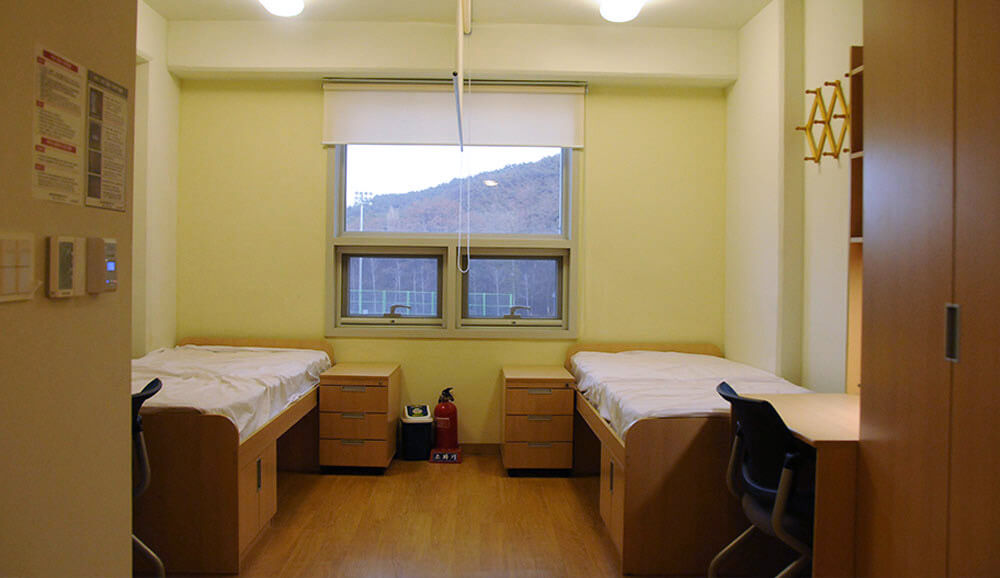
My dorm room at Seoul National University
Students who do not have enough space in the dormitory, rent "Koshivon" or "Hasukchib." Koshivon - a room in an apartment building, arranged on the basis of the hostel. Hasukchib - a room in a private house, where the mistress also prepares food.
Studio. Now I am renting a studio apartment next to the university. In Korea, such housing is called rooms. There are several types of them: “Wanrum” (one room), “Turum” (two rooms) and “Ofistel” - studio apartments, which can also be used as offices.
I have "Urumum." In such rooms live loners, for example, a man who came to Seoul to earn money, or a non-resident student.

My apartment before I drove into it. In Korean - "Urum"
Prices depend on the area. In my area, near Seoul University and academies for civil servants, there are many offers of rental housing, so prices are lower. In a month, I pay for “Wenrum” 400 000 ₩ ($ 370). I pay gas separately - 20 000 ₩ ($ 19) and electricity - 15 000 ($ 13.7). For water and the Internet, I do not pay. There is no central heating in Korea, apartments are heated with floor heating or air conditioning.
Rent my studio 3 a year ago cost in 1 600 000 ($ 1 488). I made a deposit - 1 000 000 ₩ ($ 93), paid for the first month - 400 000 ($ 370) and gave 200 000 ($ 190) to the agency.
Apartment. Renting an apartment is much more expensive. For example, a flat-ofistel with an area of 23 m² will cost 700 000 ($ 634) per month, another 70 000 ($ 62) will have to be paid for utilities. The problem is a huge deposit - 10 000 000 ₩ ($ 8 944).
In such apartments there are people who have already got a job, but have not yet brought up their family.
It is convenient to search the apartment through applications, the most popular ones - “Zigbang" and "Da bang". There you can filter offers by distance from the metro, the size of the rent, deposit and so on.

The deposit for this apartment is 10 million won, the monthly fee is 700 000 won
Public Transport
In Seoul, all transportation is very comfortable. It is cool in summer and warm in winter. In the subway, for example, heated seats.
In the app "Go Pyeongchang" you can see the time and cost of travel for all types of transport. He was released specifically for the Winter Olympics:

Metro. In the subway well catching mobile communications and wifi. The price of one trip within 10 km - 1250 ₩ ($ 1.1).
Unlike the Moscow subway, each station has free clean toilets. The only negative is that you have to wait a long time for the train, minutes 10 — 15. If it is not rush hour, of course.
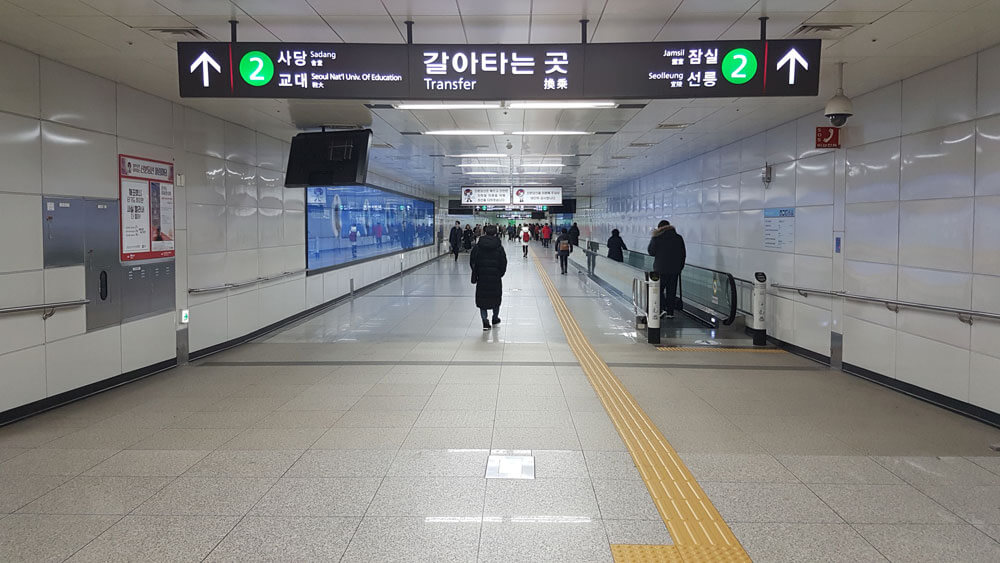
Metro in Seoul is not as beautiful as in Moscow
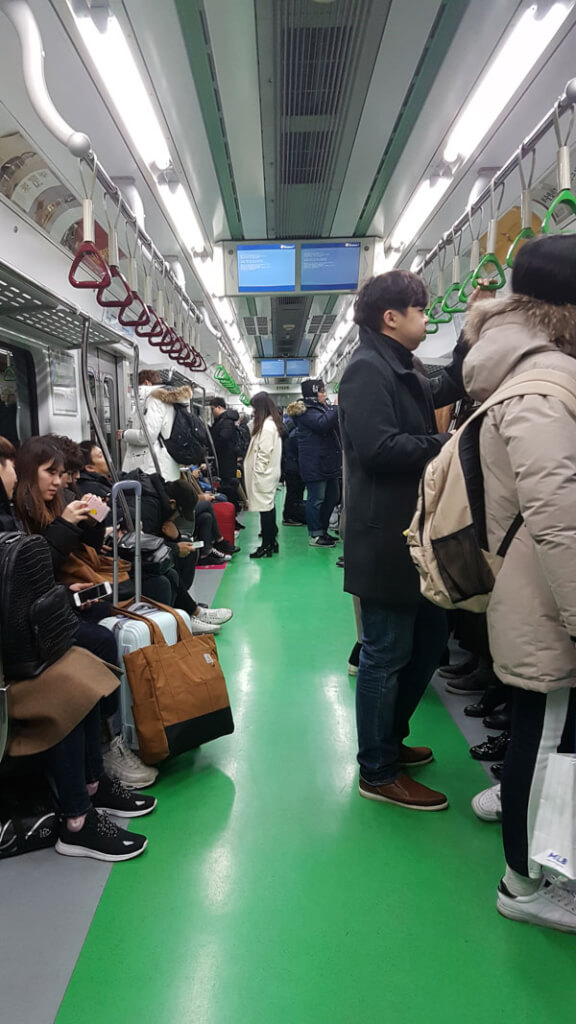
But it is clean and convenient to use.
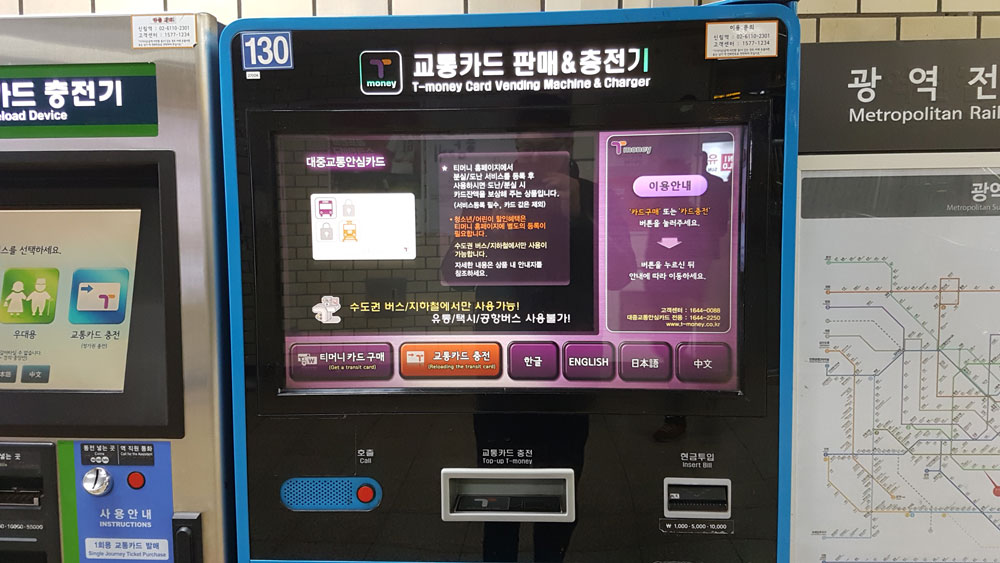
In such machines sell transport cards. Put money on the card for travel. If you pay in cash, each trip will be more expensive on 100 (5 P)
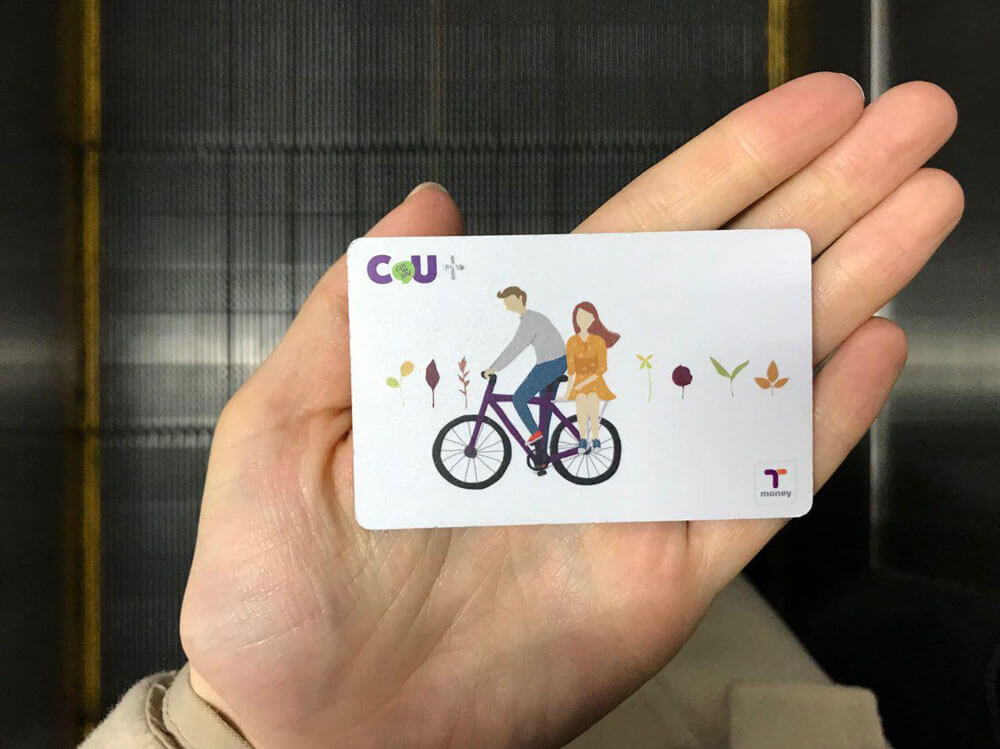
Metro transport card, they have a different design. Cards are sold in terminals at the metro station and in convenience stores.
Buses. The trip is paid by transport card or cash. Large bills will not be accepted - prepare money in denominations of 1000 or 5000 ₩. The price of a trip on 12 km - 1200 ($ 1). The transfer system is very convenient. If you made up to 3 transfers within half an hour (after 21: 00 - within an hour), then you only need to pay extra 100 won.
Routes are distinguished by color. Green buses run for short distances in the same area. Blue buses pass through the entire city, connecting remote areas. Red and yellow buses go to the suburbs.
Taxi. The trip is paid by the meter. The price of a trip on 12 km - 10 700 ₩ ($ 9.6). I rarely use a taxi, only if I go with my friends.
Bicycles. Convenient bicycle rental appeared in Seoul a couple of years ago, this network is constantly expanding. For rental made a mobile application. There you can see how many bicycles are at a particular stop.
The first hour of rental costs 1000 ₩ ($ 0.9), every subsequent half hour - the same amount.
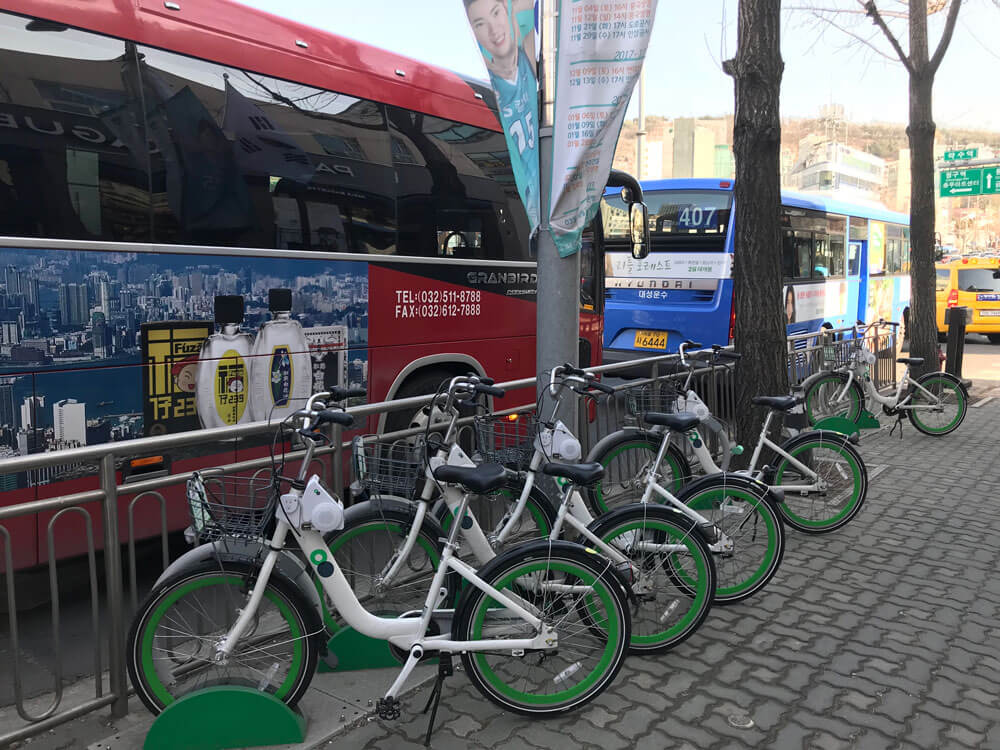
You can also choose and book a bike through the mobile application.
Religion
In Korea, slightly more than half of the population are atheists, in second place are Protestants, and in the third place are Buddhists. Therefore, the first thing that may surprise in Seoul is a huge number of churches, not distinguished by outstanding architecture. Often the church is an ordinary building, sometimes even residential, over which the cross towers.
If you decide to talk to a preacher, you will be told that you speak Korean perfectly, will offer to drink coffee and talk about the problems and your life in Korea. If you listen to the end, you will begin to explain the philosophy of Protestantism and will be invited to serve. For the coffee that was offered to you, at the end of the conversation they will be asked to pay.
Therefore, I advise you immediately respond to obsessive preachers that you are busy or in a hurry.
School
Studying in South Korea is stressful.
As in Russia, children go to school with 7 years. In Korea, age is considered different, so in Korean it is 8 years. Education takes 12 years: elementary school - 6 years, middle - 3 of the year, senior - 3 of the year.
Koreans study from morning to evening. After classes, they do their homework - right there at school - and then go to additional classes at the so-called academies. These are small private schools, where they learn to play the piano and guitar, foreign languages, additionally deal with school subjects.
Parents try to load children to the maximum, so schoolchildren return home at 11 — 12 hours of the evening. On the one hand, parents understand that it is very difficult for children. On the other hand, to sit at home and laze in Korea is not accepted. Koreans are dependent on someone else's opinion: if the son of her mother's girlfriend is learning to play a musical instrument and additionally learns two foreign languages, it means that you also need to enroll your child for some courses.
As a rule, in elementary and middle school Koreans go to public schools. They are free, except for additional services. In high school, the child is trying to give to a private school - if the family, of course, has money. In Seoul, foreign languages schools are considered the most prestigious, they are paid, there is a big competition.
The main goal of an ambitious high school student is to pass a state exam for a decent grade and enroll in a good university. This is the only way to get a high-paying job in a large corporation - in Samsung or Hyundai. If the student passed the exam is not as good as he wanted, he can wait a year and pass the exam again. So many do.
University
Higher education is paid. At Seoul National University, the cheapest faculties are humanities, law, and the faculty of management. The cost of annual training - 2 611 000 ₩. The most expensive faculties are veterinary and pharmaceutical, 4 650 000 ₩ ($ 4 196) per year. Consider that this is a state university, so the cost of education here is several times lower than other universities.
Most universities in South Korea are private. To study fully for free, you need to get a scholarship from a foundation or corporation. It is necessary to pass a series of tests and serious interviews, few manage to get among the lucky ones.
In all of South Korea, only about ten universities are considered prestigious. For the three best universities, Koreans have come up with the designation SKY, by the first letters of the titles: Seoul National University (Seoul National University), Korea University (University of Koryo), and Yonsei University (University of Yonse). A Korean who wants to work in a large corporation will try to enroll in one of these three universities.
Many Koreans, especially men, late graduate from university - it is normal to study before 30 years in Korea. Education is delayed because of the army: it is customary to go to the service after the first or second year. The service takes 2 of the year. It is impossible to repent: there is no bribe, and, most importantly, the Koreans themselves are suspicious of those who have not served.
It is also customary among students to take academic leave and leave for internships abroad - for six months or a year. They do this to increase their value in the eyes of the employer. For the same, Koreans collect a portfolio - receive certificates of computer software, pull a second foreign language, pass TOEIC - Exam on the level of proficiency in English, which is required in all companies without exception. In this test, you can earn a maximum of 990 points. A good score is 850 points and above. In the "Samsung" and "Hyundai" take with the results of 900 points.
Medicine
Medical insurance is not necessary for foreigners. For example, I do not have it, no one has ever asked about it. Nevertheless, I am going to arrange it, because medical services are expensive. The insurance will cover from 40 to 70% of the amount of treatment, and in case of hospitalization, the insurance will pay 80% costs.
While I know that the monthly cost of insurance for working foreigners depends on the size of the salary. The amount of earnings - at least 280 000 ₩ ($ 258) - is multiplied by the insurance premium rate - 5,08%. An employee who earns 1,5 million ($ 1 376) per month will pay each month for 76 200 ₩ ($ 69) insurance. Half of the amount he compensates for the employer.
Insurance is better to issue immediately, as you arrive in Korea. I didn’t do it in time, and now I’m making contributions for all the months I spent in the country. If you go to Korea to study, you can negotiate with the university so that he can get you insurance.
All hospitals in South Korea are private, the largest are located at universities. There are many Russian patients in them - they come to be examined or treated for serious diseases, such as cancer. Institutions usually have centers for foreigners with a staff of translators.
I went to the reception in more budgetary clinics. Recently, in a large medical center did US abdominal - without insurance paid 167 400 ₩ ($ 155), another 30 000 ₩ ($ 27.5) was worth a doctor's appointment.
She turned to therapists in small private hospitals with a cold — there are many of them near the metro. The doctor examined me, wrote out a prescription for pills, I paid for it and took the medicine. You do not need to pre-register - just came and waited for your turn. I paid for a doctor's appointment and pills around 30 000 ₩ ($ 25.8).
In Seoul, round-the-clock pharmacies only work in certain areas, the rest are closed in 18: 00. Without a prescription, you can buy the simplest medicines, vitamins and ointments.
Hospitals are also closed after 18: 00, except for emergency rooms. Koreans are ideal patients. In a situation where we will call an ambulance, they will go to the hospital, by car or taxi. Ambulance on the streets I saw only a few times.
Koreans often use droppers, including those for mild ailments. There are even special droppers for a hangover. A cold can be cured with an injection if you visit a doctor when the first symptoms appear.
Oriental medicine is popular with the older generation, where they are treated, for example, with acupuncture. Older people often go not to regular clinics, but to the clinic of oriental medicine.
Cellular and Internet
Communication services in Korea are expensive. For 2 Internet gb, 100 messages and 200 minutes of calls per month I pay 43 000 ₩ ($ 40).
Buying a sim card is the most difficult thing I had to do during my life in Seoul. Although you only need to come to the office of cellular communication and enter into an agreement. The difficulty is that they will ask you for a foreigner card, and its registration takes time. I was able to buy a sim card only after 3 weeks after my arrival - all this time I was without communication.
Foreigners can use prepaid sim cards - they are easy to buy, but they are very expensive. For example, a sim card on 5 days costs 28 $ - this amount includes 100 minutes of calls to local numbers and unlimited Internet.
The quality of communication in Korea is good. All operators have mobile applications where you can control the balance, watch the rest of minutes, connect and disconnect services.
There are no problems with home Internet: as a rule, it has already been held in a rented apartment and is included in the rental price.
In large cities, it is easy to connect to Wi-Fi, there are open networks in all public places, even in hospitals. In the metro, each carrier has its own Wi-Fi - only subscribers can connect to it.
Food and Food
In Korea, the cult of food. You can not skip meals, you must have breakfast, lunch and dinner, preferably at the same time. At work, even the busiest employees take a lunch break. Dine made with colleagues in canteens or cafes.
The basis of Korean dishes is rice and kimchi, spicy pickled cabbage. All dishes are spicy. Koreans have two main seasonings - pepper powder and pepper paste, they are added everywhere. When I moved it was the hardest thing for me to adapt to spicy food.
In a traditional Korean restaurant, free snacks will be brought to the order - kimchi, sprouted soy sprouts, pickled radish, spicy oden - a Japanese fish meal snack. They did not hear about Korean carrots popular in Russia in Korea, they are served only in Russian or Uzbek restaurants.
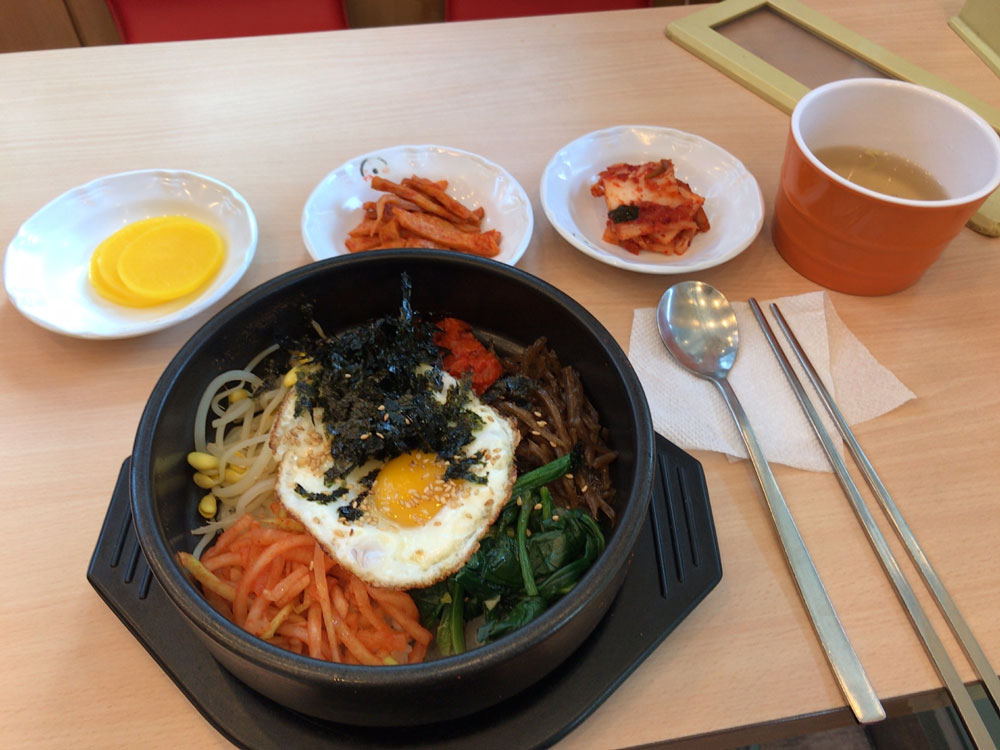

In Korea, many cafes with healthy salads. The most popular salad, especially for girls, with salmon and avocado, costs 11 000 ₩ (590 P)
After eating, Koreans always drink coffee. There are many coffee shops in Seoul - near any subway exit you will find 4-5 establishments. There is always a Starbucks near the metro, where there are almost never empty seats, especially at lunchtime. An Americano at Starbucks costs 4100 ₩ ($3.7), in other chain coffee shops it costs 3500–4500 ₩ ($3.2–$4.12).
I buy products in supermarkets, there is a large selection. I try to go shopping at Costco - it's an American network. It's cheaper there than in Korean supermarkets, and more European food.

In Seoul, I buy about the same as in Moscow
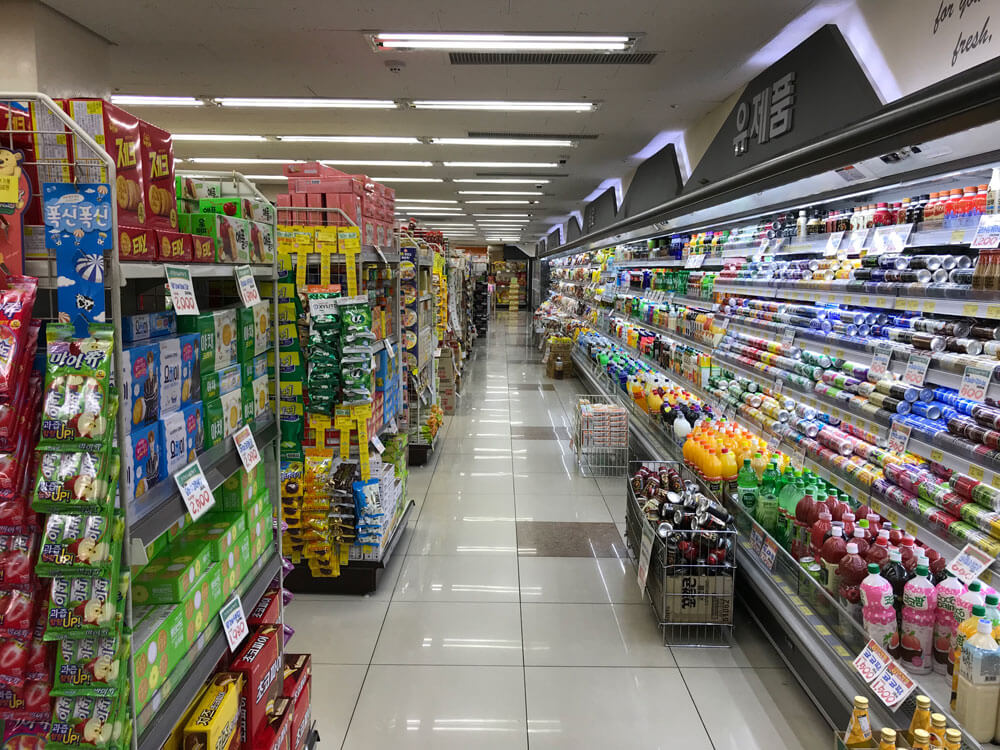
"Supermarket" is pronounced "math" in Korean.
From the usual products I can not find the cottage cheese, it is difficult to find hard cheese - it is sold only in large stores and is much more expensive than in Russia.
Prices in the supermarket are:
- Skimmed milk, 1 l - 2400 ($ 2.2).
- Cucumbers, 5 pcs. - 1980 ₩ ($ 1.8).
- Carrots, 4 pcs. - 1980 ₩ ($ 1.8).
- Chicken breast, 400 g - 6000 ₩ ($ 5.5).
- Bananas, branch - 3980 ₩ ($ 3.6).
- Eggs, 30 pieces - 3480 (#3.18).
In the hypermarket, you can issue a bonus card - in Korean "point-khadi", from the English point card. Then with each purchase you will return a certain percentage of the amount with points. You can use bonuses when buying movie tickets, cosmetics, other things and thus save. If you go to Korea for a long time, I advise you to get such cards immediately upon arrival and register them in the application. Then, when you buy, you can only show the electronic barcode.
Sometimes I go to the markets. Economical housewives come here for fresh meat and fish, vegetables and fruits, national pickles. Prices here are much lower than in supermarkets. Markets are usually located deep in the residential area, they are difficult to find.

The application that stores information about my bonus cards. Bonus programs in Korea are very popular.
Entertainment and recreation
Korean families love to spend time in the parks. There are many of them in Seoul, the most popular place is the park zone along the Hang River. Here you can ride bicycles and book a tour of the river. The cheapest day excursion costs 15 000 ₩ ($ 13.76). At noon, you can take the boat where the buffet works - it costs 39 000 ₩ ($ 36.12).

The tour can be booked on the cruise company website.
But the main entertainment in the park is to sit on the bank of the river, order roast chicken and beer and enjoy. For such leisure, even the special name “chimek” was invented, the words “chicken” and “beer” are combined in it. Chimek and generally picnics are fun for spring or autumn. Companies spread blankets on the lawn, take out or order food and communicate: chat, watch videos, play, drink. You can bring a tent with you and relax in it - as if you had left the city for nature.
Shopping is another popular leisure option with family or friends. In large cities it is full of shopping centers with restaurants, bars, cinemas - in the mall you can spend the whole day.
In Seoul, baths and saunas are popular, they are visited with family or friends - mostly middle-aged people have a rest. A simple version with shower cubicles and a common pool costs 10 — 15 thousands of won ($9.46 - $ 13.7) on weekdays and 15 — 20 thousands won ($ 13.7 — $ 17.2) on Saturday. There are whole spas where you can book a massage or a mask. There are also baths in which you can stay for the night. This option is often chosen by travelers who do not want to spend money on a hotel. That's just going to sleep on the floor.
Pupils and students of junior courses spend time in the Internet cafe for computer games. Pisi-ban, or computer rooms, work until late at night. Often they have their own cafes - to order food, you don’t even have to get up from the chair.
Middle-aged and older Koreans love to go to the mountains. No matter where you are in South Korea, there will always be a small mountain nearby, which you can climb.
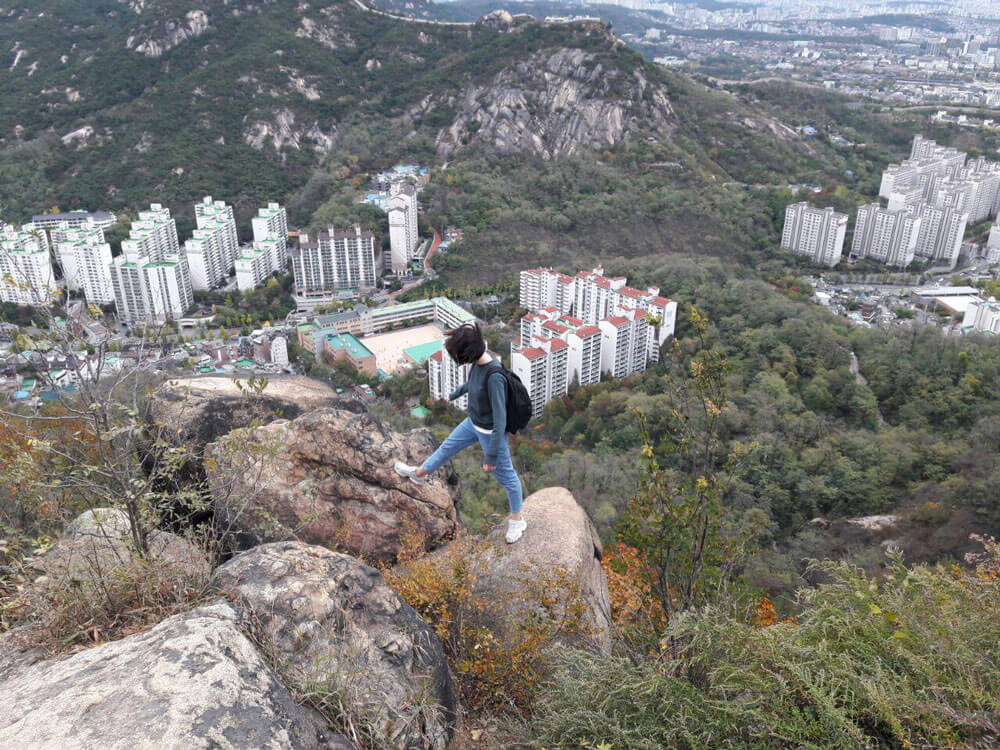
This I climbed a mountain near the University Yonse
If there are several weekends, they often go to neighboring provinces: in Gangwon-do, famous for its beautiful nature, and on Jeju Island - the most popular resort in South Korea.
For three days you can go abroad. The most popular destination is Japan. For Koreans, there is a visa-free regime; you can get there by boat, so the trip turns out to be quite budget. You can still go cheap to China.
If you have a lot of money and days off, most often you go to America or Western Europe. Especially love France, every Korean girl wants to spend a honeymoon in Paris.
Beauty and plastic surgery
Korean women take good care of themselves. They always color, curl or straighten hair, change the image every two months - of course, if they can afford it. Even the garbage will not go to throw out without cosmetics - it's about them.
In Seoul, a huge selection of hairdressers and beauty salons. I sign up for a haircut in the Cocoa Hairshop app. I choose a hairstyle, a master, a date and immediately pay for the service.

Perm costs 182 000 ₩ ($ 172), a haircut - 72 000 ₩ ($ 65.36), perm with a recovery procedure and a haircut “My dear hair” costs 266 000 ₩ ($ 240.8). Koreans like to give unusual long names to their services, for example, “A waving that will force your boyfriend to open his wallet”.
I go to a manicure in small salons near the subway. A gel polish manicure costs 40 000 ₩ ($ 36.12). Some hairdressers offer a cash deposit - from 200 000 ₩ ($ 180) - and for this they seriously reduce the price, approximately by 30%. This is called “chavon kaip” and literally means “to get a membership” in the salon. Try it if you are going to Korea for a long time.
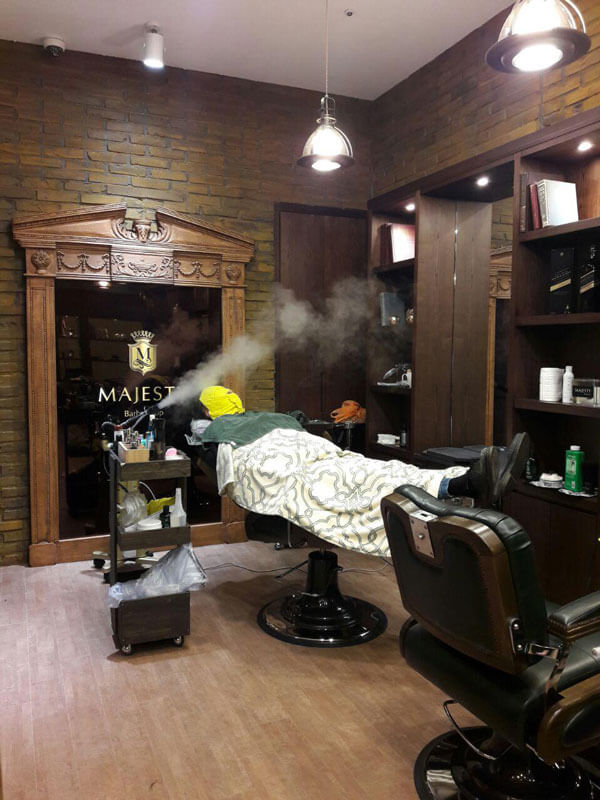
Facial spa treatments
In beauty salons they often offer sets: two services combine and give an impressive discount. You can also buy a coupon with a discount for several visits - such promotions are often carried out at the opening of new stores. For example, I bought a coupon for three visits to the salon, each visit included a haircut and a spa procedure. Coupon worth 120 000 ₩ ($ 110), while one salon visit would cost 90 000 ₩ ($ 82.5): 40 000 ₩ ($ 36) for a haircut and 50 000 ₩ ($ 46.5) for spa treatments.
Appearance in Korea plays a huge role. Beauty is a guarantee of success and high salary. Appearance is taken into account when applying for a job and is often a decisive factor. Attractive foreigners with blond hair and blue eyes can easily find work in South Korea - the demand for such models is huge.
Therefore, plastic surgery in Korea is as familiar as the treatment procedures. For the ideal, the Koreans took the European type of face: large eyes, a straight high nose, a V-shaped chin, a small oval of the face - the size of a fist, as the Koreans say. Operations that help remake a person under this standard are the most popular.
At the end of school, parents give their girls an operation - to make a crease in the eyelid so that their eyes appear larger.
Another popular operation is a change in facial contours. Korean women break their cheekbones to make the chin triangular, in shape the letters V.
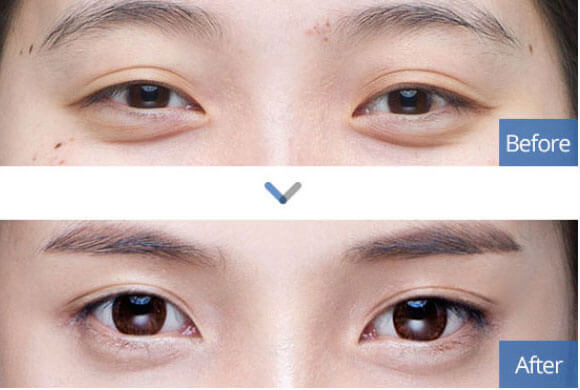
One of the most popular procedures is changing the shape of the eyes.

This girl's eyes were enlarged, the shape of her jaw and nose was corrected, her forehead was made larger, her breasts were reduced and liposuction was done. Now it will be easier for her to find a good job and get married successfully.
South Korea is considered one of the capitals of plastic surgery. Thousands of companies offer tours to Seoul to cosmetologists and surgeons. I think this is the result of the so-called Korean wave, when Korean music and series began to be popular in Asian countries. The girls who watched them wanted to be like popular actresses - and the Korean surgeons offered a solution.
Plastic surgery in Korea is much cheaper than in Europe or America. In Korea, blepharoplasty - the operation to change the shape of the eyelids - costs about 1000 $, while in America you have to pay no less than 6000 $
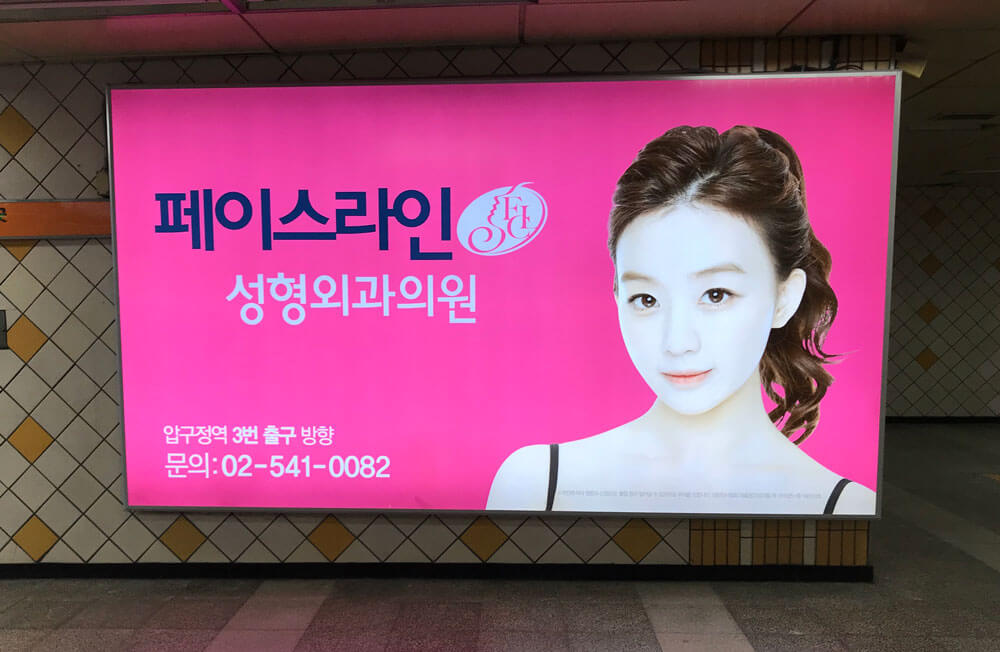
These are the girls who look at me every day on the way to work. I am going along the third line - it is on her that all the most prestigious plastic surgery clinics are concentrated at Shchins and Apkudjon stations
Language and communication
Korean is based on the alphabet - only 44 letters, very rarely Chinese characters are used. The main difficulty lies in the abundance of sounds that are not in the Russian language. Even in the Korean alphabet, two letters “o”, “e” and “n” are difficult to distinguish.
I first came to Korea when I was in my second year, by the time I studied Korean for two years Moscow State University - They focused on the study of grammar, so I did not understand the language well and spoke poorly. I could say simple phrases: “How much it costs,” “This is tasty,” “This is spicy,” but I could not issue a sim card and explain myself at the immigration center. Just having studied in Korea for a year, I began to feel confident in everyday situations.
In large cities, you can find free Korean language courses. Volunteers work there, so I'm not sure that you can learn the language well this way. In addition, there are programs for the adaptation of immigrants in Seoul, a center for supporting multicultural families is operating. In particular, foreigners are taught the Korean language, tell them about the traditions, explain how to behave in shops, banks and solve other domestic issues.
If you know English, you will have no problems in the tourist places of South Korea. At the airport, all signs and signs are duplicated in English, in the subway station announce in four languages. But in solving everyday issues, English will not help: in general, Koreans do not speak this language well, because they learn, first of all, grammar and writing.
Cultural differences
During my life in Korea, I got used to the fact that the staff in the service sector are polite and friendly. I have never felt any discomfort due to the fact that I am a foreigner or, maybe, somehow not so dressed. It will always offer to sit down, drink tea, bring a pad.
But this standard politeness extends to personal relationships. Koreans never show their emotions. When you meet someone, it is difficult to understand what a person really thinks about you. If a Korean doesn't like something, he will never say so directly. But behind your back is sure to discuss.
Life in Korea is a competition in all areas. I have many Korean friends, but, for example, in the magistracy I did not make friends with anyone. From the point of view of a Korean, every student is a rival. You will be treated well only if you are fully immersed in your studies and go everywhere with a teacher. If you work and because of this sometimes you have less time than others, they will try not to get involved with you.
Koreans are very dependent on the opinions of others. I see this from my acquaintances: if they find out that a friend has a new car or a new good job, they will be worried and will try to catch up with them. You cannot sit on the spot: you need to study more, earn more, get the most prestigious job, buy a good apartment and car. It is contagious - I, too, was involved in this race.
With the result that
I have been living in Seoul for the fourth year, and I plan to continue to stay here. In Seoul, convenient transportation, developed services, you can get a good education and find a decent job.
My expenses in Seoul per month
| Spending | Price |
|---|---|
| Apartment rental and payment Housing and utilities | 400 000 ₩ ($ 368) |
| Food and coffee | 600 000 ₩ ($ 550) |
| Transport | 80 000 ₩ ($ 74) |
| Cultural leisure (two visits to the cinema and two visits to exhibitions) | 50 000 ₩ ($ 46.4) |
| Total | 1 130 000 (1038.4) |
If you plan to study in South Korea or move here, then first of all I advise you to learn the language. It’s better not to go with level zero: it will be too difficult to adapt. You also need to be prepared for the fact that sometimes you will be seen or even discussed, especially if you have blond hair. Koreans who have not been abroad have a million stereotypes about Europeans - this can make communication difficult or even nullify it.
Think a hundred times if you want to raise your children under the stress of endless struggle - first for a place in kindergarten, and then for a place in the office.
If you are not afraid of all this, you know Korean well, and ideally also English, are willing to work hard and adapt easily to a new culture, then welcome.
Read also on ForumDaily:
How in Washington they teach to love Georgian dishes
Personal experience: Airbnb - private housing anywhere in the world
Rules of life: how much money you need to live in New York
Ours in the USA: why being poor in America is expensive
Subscribe to ForumDaily on Google NewsDo you want more important and interesting news about life in the USA and immigration to America? — support us donate! Also subscribe to our page Facebook. Select the “Priority in display” option and read us first. Also, don't forget to subscribe to our РєР ° РЅР ° Р »РІ Telegram and Instagram- there is a lot of interesting things there. And join thousands of readers ForumDaily New York — there you will find a lot of interesting and positive information about life in the metropolis.
-
Personal experience: who and why you should not move to the USA5614
-
50 diseases whose presence will increase the cost of health insurance in the USA4329
-
Great opportunities with ChatGPT: 12 easy ways to make money using artificial intelligence1324
-
What should not be on your resume if you want to find a job in the USA763
-
Four unforgivable mistakes immigrants make to the United States552
-
Dependence on cars and one supermarket per city: why ours is unusual in one-story America403
-
Ten secret restaurants in the USA: what is their highlight and how to find them254
-
Personal experience: who and why you should not move to the USA5614
-
Where in the USA to buy the medicines we are used to: a list of pharmacies5330
-
How to hit the jackpot: tips from a man who won the lottery 7 times4898
-
50 diseases whose presence will increase the cost of health insurance in the USA4329
-
Street, avenue, boulevard or drive: how to understand the classification of US streets and roads1461
-
Personal experience: what not to do in America1402
-
Great opportunities with ChatGPT: 12 easy ways to make money using artificial intelligence1324











